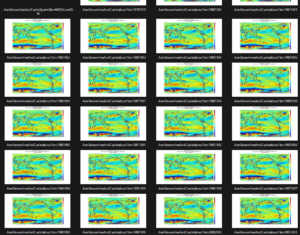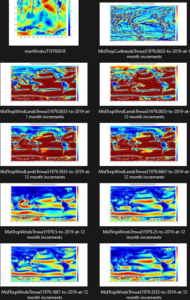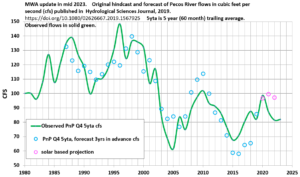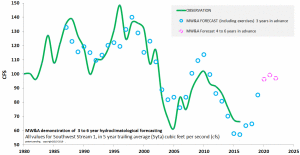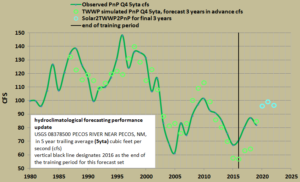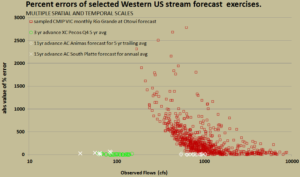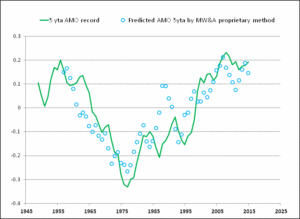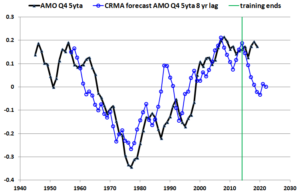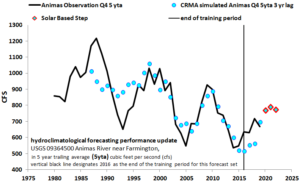Observations and Forecast Record
Update September 2023.
In contribution towards a manuscript which cites [1], I’ve produced a new page at (to be added as manuscript is submitted)
These are snapshots from the full sets. Please if used, attribute [1] and this site, and me, and dig down to consider whether or not to tip. No market for accurate hydro forecasts, so monetization is challenging.
Update August 2023.
Now that sufficient time has passed, the complete results of several forecasts profiled in Wallace, 2019, Hydrological Sciences Journal, https://doi.org/10.1080/02626667.2019.1567925, can be compared to the resulting observations. First, here is the graphic result of observations versus projections for the Pecos River, near Pecos, NM.
Also, the quantitative skill of the forecast can be evaluated, which I’ll attend to soon. Two other river forecasts from that study can be updated: for the Animas and Gila Rivers.
Earlier postings remain relevant of course as they document forecast skill:
This page offers a brief sample of forecasts I’ve produced. They could be compared to any long range climate projections in the world in their respective categories. No sites exist to rank climate forecast accuracy to my knowledge, so I’ve worked to compare at this page where relevant. Recently a paper I authored which relates some of these forecasts and other global hydrologic phenomena to solar causality, has been published in the Oxford based Hydrological Sciences Journal [1].
Unlike conventional parametric products or projections based on uncalibrated global circulation models (GCMs), my forecasts derive from long term lagged correlations between precursors identified through my past research efforts. These are accordingly Cross Regression Moving Average (CRMA) exercises. In the examples below, a training period is utilized to show the ability of the method from an early time through to the end of the year 2016. The actual prediction period (the test period) follows from that point on.
CATEGORY 1. LONG TERM HYDROLOGIC FORECASTS
Long term global temperature qualitative projections that I proposed nearly 1 decade ago in a public debate are turning out to be correct, as this VERIFICATION 2021 POST details.
I first published this 3 year advance forecast of a 60 month average for a stream in the Southern Rocky Mountains in early 2016. (CLICK ON THE FOLLOWING CHART TO ANIMATE)
I have added a single frame update below. This extends the comparison to the observations ending at the end of 2018.
The projections of this forecast continue to demonstrate high fidelity to the subsequent streamflow observation record. For example, the following chart shows a summary of the accuracy performance of all of my streamflow forecasts that I have posted at this site since the end of 2015, and compares those to the accuracy of predictions by the West-Wide Climate Assessment (red points) for a stream in the same region. This chart demonstrates that MWA’s forecasts are significantly more accurate than the ruling emissions-based climate change paradigm. A more comprehensive description of this comparison is available at this update.
CATEGORY 2. LONG TERM TEMPERATURE FORECASTS
Also in early 2016, I first published this 8 year advance forecast of a 60 month average of the Atlantic Multidecadal Oscillation (AMO), which is an integrated index of surface temperatures across the Atlantic Ocean. The AMO is widely known as one of the most important natural temperature indexes of our time. (CLICK ON THE FOLLOWING CHART TO ANIMATE)
Again, the projections of this forecast continue to demonstrate high fidelity to the subsequent AMO observation record. Links of relevant interest that also develop further statistical performance metrics include this original post, and this followup post.
Here is a partial update of the AMO forecast. Currently this forecast is diverging from observations at a notable scale but not without precedent across the training period.
The underlying methods which yielded this record of success are based on unique approaches and perspectives regarding hydrology, the atmospheric circulation, and solar forcing. The components of each are featured in posts at this site and in a set of papers and research in progress. Any reader is encouraged to explore the interconnected climate topics here and to ask questions of their favored experts which may relate.
Special Profiles
The Animas River cat 1:
I have made a forecast for flows in the Animas River as well. The format and scale are similar to my Pecos forecasts. Both have have been featured in a recent published paper of mine. The Animas result is presented below, updated through to the end of 2018.
The Santa Fe River cat 1
See this November 2019 news update on forecast performance for this river
Model Ensemble Evaluation Projects
I consider forecasts to be somewhat synonymous with projections and simulations. Currently however at this site each forecast is a unique human effort / exercise using standard ARMA and related tools and resources [1]. In contrast, typically numerical simulations of regional hydroclimatology such as VIC [2], are based on large numbers of automatic runs with apparently little independent review.
MW&A has proven expertise in the quantitative stochastic evaluation of hydroclimatological risk assessments based on multiple ensemble hydro-numerical simulations.
Example 1. GRASP-INV [3] was a numerical simulator of fields of equally-plausible hydraulic conductivity fields for an aquifer of importance for geologically-long-term waste disposal activities. To be equally-plausible, each run of the code would have to satisfy special aquifer pump-test observation records. The inverse hydrologic realizations were to then be fed into an overall long term aquifer flow and transport simulation performance assessment ensemble exercise. Towards this end, 100 equally-likely synthetic hydraulic conductivity maps were generated by GRASP-INV. When requested to review, MW&A’s founder immediately identified that the maps were structurally incorrect (ironically due to an inversion of another type). All maps were regenerated by replacement GRASP-INV computer runs from scratch over approximately one month.
Example 2. VIC HIGHLIGHTS are the hundreds to thousands of hydroclimatology VIC runs which have been grafted on to 112 specifically blessed UN IPCC CMIP-5 global circulation models. In blogs here I write about VIC whenever I refer to other emissions-based hydroclimatology causation models for the western US. Those include conceptual and other models of the Early Spring, Massive Tree Mortality, and Megadroughts.
Example 3. I’m still waiting for the solar hydroclimatology reproducible models of mine and others to take wings. Then when they find applications as alternative climate forcing agents, there will be many new runs of a more reproducible flavor. Those will always benefit from additional and competitive independent comparisons to what best works.
References
[1] Wallace, M.G., 2019, Application of lagged correlations between solar cycles and hydrosphere components towards sub-decadal forecasts of streamflows in the Western US. Hydrological Sciences Journal, Oxford UK Volume 64 Issue 2. doi: 10.1080/02626667.2019.
[2] Variable Infiltration Capacity (VIC) model, numerous citations available
[3] https://www.osti.gov/servlets/purl/431195 The use of GRASP-INV in context is described in this 1996 paper.
 8633total visits,3visits today
8633total visits,3visits today
